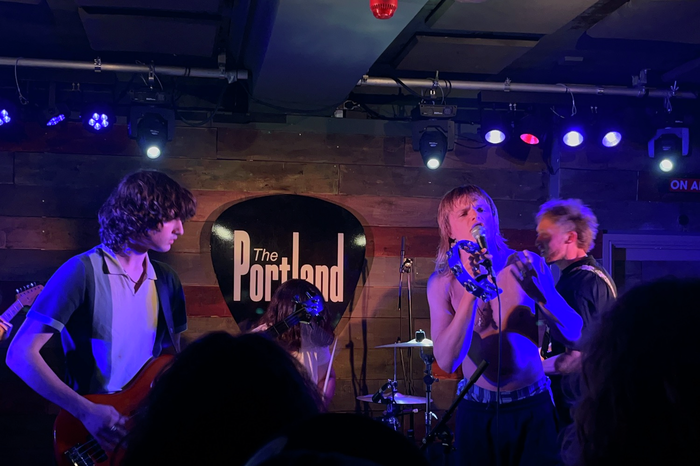Does the Eras Tour portray the ‘real’ Taylor Swift?
Lyra Christie explains why attending the Eras Tour was a form of classics revision

When I told my DoS I’d decided to see Taylor Swift with one exam still to go, he wasn’t so much disappointed as resigned. After all, I compared her to Ovid in my personal statement, I’m the CUTSAS Events Officer and, at any classics drinks event, I can usually be found drunk in the corner, extolling Taylor’s musical virtues to anyone who will listen. He’s used to it. And I assured him I’d revise on the train.
As everyone else settled in for one last weekend in the library, I set off to Edinburgh’s Murrayfield Stadium. True to my word, I made a valiant attempt to revise for my last exam, Constructs of Classical Art, on the train. This was followed by a more half-hearted effort to do some reading in the queue, distracted by swapping friendship bracelets with fellow attendees and being dive-bombed by seagulls – the worst 1989 Easter egg ever.
“The Eras Tour film doesn’t do justice to how brightly Swift’s sequinned costumes sparkle”
Though I’d spent all day trying to stop thinking about Taylor and focus on artistic representation, it was when the concert started that those concepts really clicked into place. There’s a tendency to approach Swift’s music like a puzzle which, when decoded, provides clues to her personal life, particularly her recent album, THE TORTURED POETS DEPARTMENT. But, as Swift says, “These are songs that I wrote about my life but, after tonight, I hope they’ll be about yours.” The visceral response from the crowd got me thinking about how we engage with music, associating songs with particular moments and investing them with feeling. This was particularly palpable when Swift launched into fan favourite ‘Getaway Car’ as a surprise song, prompting an avalanche of screams, sobs and frantic singing along.
Of course, some of that investment is placed, not in the music, but in the concept of Taylor Swift. The Eras Tour is designed to make as many of the 73,000 attendees as possible feel connected to Swift. The stage is massive and Swift stomps up and down, allowing the entire stadium to catch glimpses of her. The Eras Tour film doesn’t do justice to how brightly Swift’s sequinned costumes sparkle, drawing the eye. When the real Swift is out of sight, her image is all around: there’s live footage on massive LED screens and pre-recorded tour visuals of Swift curling up in ball gowns or, in one uncanny portion of the 1989 set, dancing in sync with the real Taylor. Talk about mise-en-abyme.
“I spent the first half hour sobbing every time I caught sight of Taylor in the flesh”
But the videos of Taylor can’t compare to the real thing. I spent the first half hour sobbing every time I caught sight of Taylor in the flesh. “She was so close to me!” is the giddy response I give when asked how I found the show. Much of the appeal of concerts derives from this pursuit of realness – the emotional and physical proximity to your idol associated with seeing them in person, the immediacy of hearing their music live. Yet a concert is a performance. Intimacy is a lot to ask of the biggest pop star alive, particularly as the Eras Tour has just passed its 100th show. These are routines that Swift has performed night after night after night. This produces some jarring moments, such as during ‘All Too Well’, when Swift, with increasing agitation, repeatedly demands medical assistance for a fan without missing a note. It’s not that these interruptions render the song disingenuous – but they remind us that Swift is a professional and this is a performance.
Swift doesn’t shy away from the performativity of the Eras Tour; she embraces it. She highlights the disconnect between her performances and mental state in ‘I Can Do It With a Broken Heart’, where she’s manhandled like a puppet while singing, “I’m miserable – and nobody even knows!” The very concept of “Eras” enables a series of constructed personas, dissecting Swift into different costumes, aesthetics and albums. If we come to concerts looking for the “real” artist rather than a representation of them, does the Eras Tour portray the real Taylor Swift? As I’m surrounded by images of Swift – and even when she’s right in front of me – I can’t shake the feeling I’m seeing a careful representation. At Swift’s staggering level of fame, maybe that’s the boundary she must draw – but her personhood has become part of the performance. The Eras Tour is fascinating in how Swift represents her art but also in how she constructs representations of herself.
So really, attending the Eras Tour totally counted as revision. And I so know Aristotle.
 News / Cambridge study finds students learn better with notes than AI13 December 2025
News / Cambridge study finds students learn better with notes than AI13 December 2025 News / Cambridge Vet School gets lifeline year to stay accredited28 November 2025
News / Cambridge Vet School gets lifeline year to stay accredited28 November 2025 Science / Did your ex trip on King’s Parade? The science behind the ‘ick’12 December 2025
Science / Did your ex trip on King’s Parade? The science behind the ‘ick’12 December 2025 News / Uni Scout and Guide Club affirms trans inclusion 12 December 2025
News / Uni Scout and Guide Club affirms trans inclusion 12 December 2025 Arts / Modern Modernist Centenary: T. S. Eliot13 December 2025
Arts / Modern Modernist Centenary: T. S. Eliot13 December 2025










